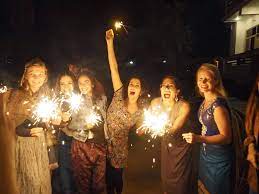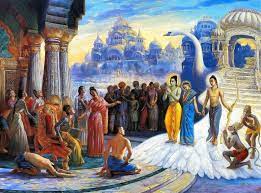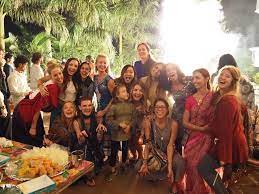The festive season of Navratri, in commemoration of the Goddess Shakti, reaches its heights in the Indian month of Kartik (October-November) on the day of Diwali. Rishikul Yogshala wholeheartedly reveled this year in the spirit of communal joy and festive spirits that overwhelmed India on Diwali.

Being a frontline yoga teaching organization in the country, Rishikul Yogshala took this opportunity to convey the value of this age-old ritual of Indian culture and its relationship with spiritualism and yoga to its international students and followers.
Mythological Origin and Symbolic Value of Diwali
Diwali or Deepawali literally means a row of light. This light stands for auspiciousness and glory of the Almighty, whose grace is believed to be all around us. At different parts of the country, tribute is paid to different deities on the occasion of Diwali. The day invokes mythological events which is a significant part of the Indian consciousness. The holy union of Goddess Lakshmi- the symbol of fortune and wealth, with Lord Vishnu- the universal creator, is one of such mythological origins of this celebration. In some other contexts in India, the festival is dedicated to Goddess Kali – the annihilator of evil on earth and the return of Lord Rama to the kingdom after defeating Ravana– the evil doer.

Such tales are rich with interesting symbolic value which relate directly to yogic concepts. The union of the Transcendental with the material world and the triumph of good over evil are key spiritual philosophies embedded in all aspects of Indian life—its social celebrations, religious rituals and day to day activities.
Celebrations Invoking Auspiciousness
Rishikul Yogshala made this day memorable by decking up its premises with dazzling lights. Innumerable diyas or earthen oil lamps were lit in togetherness by the students, teachers, and staff of the school after nightfall. This firelight is believed to ward off evil temptations and usher in good spirits in the hearts of the yogic practitioners. As per India’s colorful customs, rangoli or designs with colored powders are also made in the school. Rangolis are made typically of auspicious symbols, that of the flowers and birds of India.

The Rishikul family also witnessed a havan or fire ceremony this night of lights and colors. It is a transforming experience for many to throw offerings in the fire and let the sonorous mantra chants enter deeper into the consciousness during this auspicious fire ceremony.
The night came to an end with hundreds of mesmerizing fireworks engulfing the sky, penetrating the darkness of nature and human minds with the light of love, peace and unending joy!





